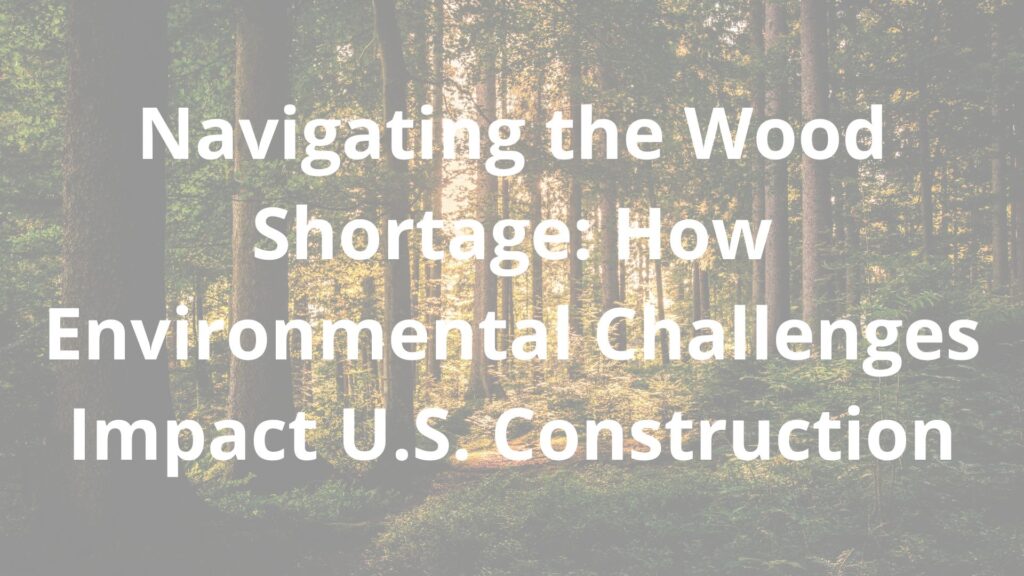
The rhythmic hum of sawmills and the steady rise of new structures have long been hallmarks of the American landscape. Wood, a foundational material in U.S. construction, has historically been abundant.
However, this seemingly endless supply is increasingly threatened by a confluence of environmental challenges, most notably the escalating intensity and frequency of wildfires. These ecological disruptions are not merely localized events; their ripple effects extend throughout the entire lumber supply chain, creating significant economic and practical hurdles for the construction industry nationwide. This article will delve into how wildfires and other environmental issues are limiting lumber availability and consequently impacting the vital sector of U.S. construction.
The Scorched Earth: Wildfires’ Devastating Impact on Lumber Supply
Wildfires, once a seasonal concern, have become a year-round threat, particularly in the western United States. Millions of acres burn annually, consuming vast tracts of commercial timberland. The immediate impact is a direct reduction in the available supply of harvestable timber. When fires decimate forests, it takes decades for new trees to mature, leading to prolonged shortages. California, for instance, a significant contributor to the U.S. lumber supply (approximately 10%), has seen its forestlands repeatedly ravaged, with up to 60% of its commercially viable forests in high-risk zones.
Beyond outright destruction, wildfires create a cascade of challenges:
Salvage Logging Costs: While some fire-damaged timber can be salvaged, the process is expensive and labor-intensive, often yielding lower-quality wood. This increases production costs for lumber.
Supply Chain Disruptions: Road closures, power outages, and damage to processing plants in fire-affected regions halt or delay operations, compounding supply shortages and escalating costs.
Increased Reliance on Imports: As domestic supply dwindles, the U.S. becomes more dependent on imported lumber from countries like Canada and Sweden. While this can stabilize supply, it often comes with higher transportation costs and tariffs, further influencing domestic prices.
Cascading Effects: Reduced output from heavily impacted regions like California shifts demand to other domestic sources in the Pacific Northwest and the Southeastern U.S., straining their capacities and driving up prices across the board.
Historically, major wildfires have led to substantial cost increases. Following the 2017 Tubbs Fire, lumber prices surged by 50% within a few months. Experts predict further price increases as a direct consequence of ongoing wildfire activity.
Beyond the Blaze: Other Environmental Pressures on Timber
While wildfires are a dramatic and immediate threat, other environmental issues contribute to the constrained lumber supply:
Pests and Diseases: Climate change can create conditions favorable for the spread of destructive forest pests like the Bark Beetle. Infestations can kill vast numbers of trees, rendering them unusable for lumber and exacerbating supply issues.
Drought and Water Scarcity: Prolonged droughts, linked to climate change, stress forests, making them more susceptible to disease and fire. Water scarcity also impacts tree growth rates and the ability to reforest effectively.
Changing Forest Productivity: While some regions might see increased tree growth due to warmer temperatures and more precipitation, others, particularly drier locations, will experience reduced growth and species suitability. This uneven impact affects overall timber availability.
Land Use Competition: As climate change shifts agricultural land suitability northwards, there is increasing competition between land needed for food production and land for timber production. This could further reduce the area available for forestry.
Sustainable Forestry Practices and Regulations: Growing environmental awareness and the need for long-term forest health have led to stricter regulations and a shift towards sustainable forestry practices. While crucial for ecosystem preservation, these practices can sometimes limit immediate timber harvesting volumes compared to historical clear-cutting methods. Laws like the Clean Water Act, Endangered Species Act, and the National Forest Management Act impose guidelines on timber harvesting to protect water quality, biodiversity, and ensure forest regeneration.
Impact on the U.S. Construction Industry
The limited and fluctuating lumber supply has direct and significant repercussions for the U.S. construction sector:
Soaring Material Costs: The most immediate and tangible effect is the volatility and escalation of lumber prices. This directly impacts the cost of new home construction, renovations, and other building projects. For clients, contractors, and developers, this means higher project budgets and potential delays.
Project Delays and Uncertainties: Unpredictable lumber availability leads to project delays, making it challenging for builders to meet timelines and budgets. This introduces significant uncertainty into the construction planning process.
Shift to Alternative Materials: As lumber becomes more expensive and unreliable, the industry may increasingly explore and adopt alternative building materials, such as steel, concrete, or mass timber (engineered wood products). While these offer potential benefits in terms of fire resistance or sustainability, they often come with their own supply chains, costs, and learning curves.
Reduced Housing Affordability: Higher construction costs, driven by lumber prices, contribute to a less affordable housing market, impacting both new home buyers and the overall economic landscape.
Innovation in Sourcing and Design: The challenges are also spurring innovation. The industry is exploring more efficient use of wood, promoting recycling and reuse of timber, and prioritizing certified sustainable sources to minimize environmental footprints.
The intricate relationship between environmental health and the construction industry is becoming increasingly apparent. Wildfires, compounded by other climate-driven factors and the necessary shift towards sustainable practices, are undeniably limiting the U.S. lumber supply and imposing significant constraints on construction. Navigating these challenges requires a multi-pronged approach: investing in robust forest management and wildfire prevention, fostering the development and adoption of alternative building materials, and strengthening international supply chain resilience. Ultimately, the long-term stability and affordability of the U.S. construction sector are inextricably linked to the health and sustainable management of our nation’s forests. Proactive measures and a commitment to environmental stewardship are not just ecological imperatives, but economic necessities for building a resilient future.
John Caravella Esq., is a construction attorney and formerly practicing project architect at The Law Office of John Caravella, P.C., representing architects, engineers, contractors, subcontractors, and owners in all phases of contract preparation, litigation, and arbitration across New York and Florida. He also serves as an arbitrator to the American Arbitration Association Construction Industry Panel. Mr. Caravella can be reached by email: [email protected] or (631) 608-1346.
The information provided on this website does not, and is not intended to, constitute legal advice; instead, all information, content, and materials available on this site are for general informational purposes only. Readers of this website should contact their attorney to obtain advice with respect to any particular legal matter. No reader, user, or browser of this site should act or refrain from acting on the basis of information on this site without first seeking legal advice from counsel in the relevant jurisdiction. Only your individual attorney can provide assurances that the information contained herein – and your interpretation of it – is applicable or appropriate to your particular situation. Use of, and access to, this website or any of the links or resources contained within the site do not create an attorney-client relationship between the reader, user, or browser and website authors, contributors, contributing law firms, or committee members and their respective employers.
Resources:
- S. Forest Service (USDA): Provides extensive data and reports on forest health, timber supply, and wildfire management. Their website (fs.usda.gov) is a valuable resource.
- American Wood Council (AWC): Offers information on wood products, sustainable forestry practices, and technical data for wood construction. (awc.org)
- National Association of State Foresters (NASF): Provides insights into state-level forest management and relevant federal laws. (stateforesters.org)
- Forest Stewardship Council (FSC) and Sustainable Forestry Initiative (SFI): These organizations provide certification for sustainably managed forests and offer a way to identify responsibly sourced lumber. Look for their certifications on wood products.
- World Wildlife Fund (WWF): Offers global perspectives on sustainable timber and the impacts of deforestation. (worldwildlife.org/industries/timber)
- BuildMax / Currie & Brown Insights: Various industry publications and consulting firms regularly publish reports and analyses on lumber prices and supply chain impacts, often citing wildfire effects. (Searching for “lumber price trends” and “wildfire impact on construction” on their respective sites or general search engines can yield current analyses.)

